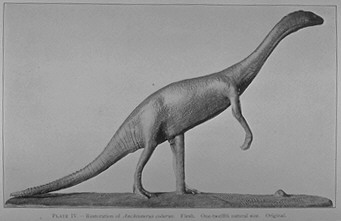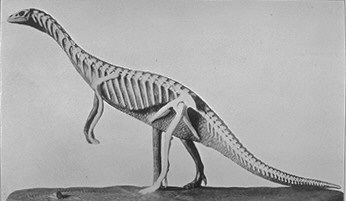38. Lull and Triassic Dinosaurs, 1915
 Most
of the dinosaurs that were discovered in the United States at the end of
the nineteenth century were from the Cretaceous period
(Tyrannosaurus and Triceratops) or the Jurassic period
(Diplodocus and Stegosaurus). However, there was one area
that yielded Triassic dinosaur remains, and that was the Connecticut River
Valley. Oddly, the fossil evidence there was mostly in the form of
footprints, the very footprints that Hitchcock
had seen as bird tracks, with actual fossils being rather scarce.
Still, in the period since Hitchcock a few skeletons had been discovered,
most notably Anchisaurus, which was restored
by Marsh in 1893.
Most
of the dinosaurs that were discovered in the United States at the end of
the nineteenth century were from the Cretaceous period
(Tyrannosaurus and Triceratops) or the Jurassic period
(Diplodocus and Stegosaurus). However, there was one area
that yielded Triassic dinosaur remains, and that was the Connecticut River
Valley. Oddly, the fossil evidence there was mostly in the form of
footprints, the very footprints that Hitchcock
had seen as bird tracks, with actual fossils being rather scarce.
Still, in the period since Hitchcock a few skeletons had been discovered,
most notably Anchisaurus, which was restored
by Marsh in 1893.
Richard Swann Lull was professor of Vertebrate Paleontology at Yale University, and Marsh's successor. In this survey article he sought to reconstruct the Connecticut Valley of Triassic times, using all known evidence, footprints and bones. To aid in this visual exercise, he made models of Triassic dinosaurs in the round, which was, he claimed, "an old idea but newly applied in prehistoric restorations." Actually, it wasn't all that new--as we have seen, Charles Knight was already in the habit of doing three-dimensional restorations-- but Lull did add a novel twist. When he sculpted his Anchisaurus, he gave one side the appearance of skin and muscle, while he cut the other side away to reveal the internal skeleton.
Lull's study is still the classic monograph on the Connecticut Triassic, and has proved so indispensable that it was reprinted in 1953.
 Source:
Source:Lull, Richard Swann. Triassic Life of the Connecticut Valley. Hartford: Published by the State, 1915. Series: Connecticut. State Geological and Natural History Survey. Bulletin no. 24. This work is on display as exhibit item 38.


 ®Linda Hall Library
®Linda Hall Library5109 Cherry Street
Kansas City, MO 64110
Please direct comments to ashwortb@lhl.lib.mo.us
